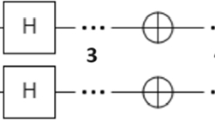Abstract
The pivot algorithm is a Markov Chain Monte Carlo algorithm for simulating the self-avoiding walk. At each iteration a pivot which produces a global change in the walk is proposed. If the resulting walk is self-avoiding, the new walk is accepted; otherwise, it is rejected. Past implementations of the algorithm required a time O(N) per accepted pivot, where N is the number of steps in the walk. We show how to implement the algorithm so that the time required per accepted pivot is O(N q) with q<1. We estimate that q is less than 0.57 in two dimensions, and less than 0.85 in three dimensions. Corrections to the O(N q) make an accurate estimate of q impossible. They also imply that the asymptotic behavior of O(N q) cannot be seen for walk lengths which can be simulated. In simulations the effective q is around 0.7 in two dimensions and 0.9 in three dimensions. Comparisons with simulations that use the standard implementation of the pivot algorithm using a hash table indicate that our implementation is faster by as much as a factor of 80 in two dimensions and as much as a factor of 7 in three dimensions. Our method does not require the use of a hash table and should also be applicable to the pivot algorithm for off-lattice models.
Similar content being viewed by others
REFERENCES
P. G. de Gennes, Scaling Concepts in Polymer Physics (Cornell University Press, Ithaca, New York, 1979).
J. des Cloizeaux and G. Jannink, Polymers in Solution: Their Modeling and Structure (Oxford University Press, Oxford, New York, 1990).
M. Lal, ''Monte Carlo'' computer simulations of chain molecules I, Molec. Phys. 17:57-64 (1969).
N. Madras and A. D. Sokal, The pivot algorithm:A highly efficient Monte Carlo method for the self-avoiding walk, J. Statist. Phys. 50:109-186 (1988).
B. MacDonald, N. Jan, D. L. Hunter, and M. O. Steinitz, Polymer conformations through ''wiggling,'' J. Phys. A 18:2627-2631 (1985).
D. L. Hunter, N. Jan, and B. MacDonald, On the correction-to-scaling exponent of linearpolymers in 2 dimensions, J. Phys. A 19:L543-545 (1986).
K. Kelly, D. L. Hunter, and N. Jan, Critical properties of the three-dimensional selfavoiding walk, J. Phys. A 20:5029-5031 (1987).
M. Bishop and C. J. Saltiel, Application of the pivot algorithm for investigating the shapes of two-dimensional and 3-dimensional lattice polymers, J. Chem. Phys. 88:6594-6596 (1988).
N. Madras, A. Orlitsky, and L. A. Shepp, Monte Carlo generation of self-avoiding walks with fixed endpoints and fixed length, J. Statist. Phys. 58:159-183 (1990).
G. Zifferer, Monte Carlo simulation of tetrahedral chains. 1. Very long (athermal) chains by pivot algorithm, Macromolecules 23:3166-3172 (1990).
S. Caracciolo, A. Pelissetto, and A. D. Sokal, Universal distance ratios for 2-dimensional selfavoiding walks-corrected conformal-invariance predictions, J. Phys. A 23:L969-L974 (1990).
A. J. Chorin, Constrained random-walks and vortex filaments in turbulence theory, Commun. Math. Phys. 132:519-536 (1990).
M. Bishop and J. H. R. Clarke, Investigation of the end-to-end distance distribution function for random and self-avoiding walks in two and three dimensions, J. Chem. Phys. 94:3936-3942 (1991).
A. J. Barrett, M. Mansfield, and B. C. Benesch, Numerical study of self-avoiding walks on lattices and in the continuum, Macromolecules 24:1615-1621 (1991).
S. Caracciolo, G. Ferraro, and A. Pelissetto, Criticality of self-avoiding walks with an excluded infinite needle, J. Phys. A 24:3625-3639 (1991).
G. Zifferer, Monte-Carlo simulation of tetrahedral chains. 4. Size and shape of linear and star-branched polymers, Makromol. Chem. 192:1555-1566 (1991).
M. Bishop and C. J. Saltiel, The distribution function of the radius of gyration of linearpolymers in 2 and 3 dimensions, J. Chem. Phys. 95:606-607 (1991).
M. Bishop and C. J. Saltiel, Structure-function of linear-polymers in the ideal and excluded volume regime, J. Chem. Phys. 94:6920-6923 (1991).
N. Eizenberg and J. Klafter, Self-avoiding walks on a simple cubic lattice, J. Chem. Phys. 99:3976-3982 (1993).
P. Grassberger, R. Hegger, and L. Schäfer, Self avoiding walks in four dimensions: Logarithmic corrections, J. Phys. A 27:7265-7282 (1994), cond-mat/9409071.
S. Caracciolo, G. Parisi, and A. Pelissetto, Random walks with short-range interaction and mean-field behavior, J. Statist. Phys. 77:519-543 (1994).
B. Li, N. Madras, and A. D. Sokal, Critical Exponents, hyperscaling and universal amplitude ratios for two-and three-dimensional self-avoiding walks, J. Statist. Phys. 80:661-754 (1995), hep-lat/9409003.
G. G. Pereira, Internal structure of polymer chains, Physica A 219:290-304 (1995).
N. Eizenberg and J. Klafter, Critical exponents of self-avoiding walks in three dimensions, Phys. Rev. B 99:5078-5081 (1996).
P. Grassberger, P. Sutter, and L. Schäfer, Field theoretic and Monte Carlo analysis of the Domb-Joyce model, J. Phys. A 30:7039-7056 (1997).
S. Caracciolo, M. S. Causo, and A. Pelissetto, High-precision determination of the critical exponent gamma for self-avoiding walks, Phys. Rev. E 57:1215-1218 (1998), condmat/ 9703250.
S. Caracciolo, M. S. Causo, and A. Pelissetto, Monte Carlo results for three-dimensional self-avoiding walks, Nucl. Phys. Proc. Suppl. 63:652-654 (1998), hep-lat/9711051.
G. Zifferer, Shape distribution and correlation between size and shape of tetrahedral lattice chains in athermal and theta systems, J. Chem. Phys. 109:3691-3698 (1998).
G. Zifferer, Shape distribution and correlation between size and shape of star-branched tetrahedral lattice chains in athermal and theta systems, J. Chem. Phys. 110:4668-4677 (1999).
S. Caracciolo, M. S. Causo, and A. Pelissetto, End-to-end distribution function for dilute polymers, J. Chem. Phys. 112:7693-7710 (2000).
N. Madras and G. Slade, The Self-Avoiding Walk (Birkhäuser, Boston/Basel/Berlin, 1993).
A. Sokal, Monte Carlo Methods for the Self-Avoiding Walk, in Monte Carlo and Molecular Dynamics Simulations in Polymer Science, Kurt Binder, ed. (Oxford University Press, 1995), hep-lat/9405016.
S. D. Stellman, M. Froimowitz, and P. J. Gans, Efficient computation of polymer conformation energy, J. Comput. Phys. 7:178-181 (1971).
L. A. Johnson, A. Monge, and R. A. Friesner, A hierarchical algorithm for polymer simulations, J. Chem. Phys. 97:9355-9365 (1992).
N. Madras and A. D. Sokal, private communication (2001).
Author information
Authors and Affiliations
Rights and permissions
About this article
Cite this article
Kennedy, T. A Faster Implementation of the Pivot Algorithm for Self-Avoiding Walks. Journal of Statistical Physics 106, 407–429 (2002). https://doi.org/10.1023/A:1013750203191
Issue Date:
DOI: https://doi.org/10.1023/A:1013750203191




